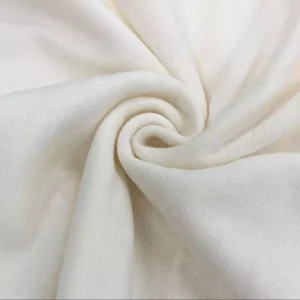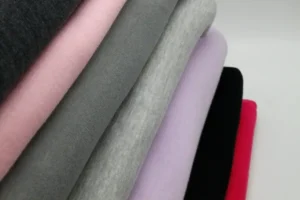10 Different Types of Best Hoodie Materials to Keep You Warm
There are lots of different materials available for hoodies. I have listed ten typical hoodie fabric types here. You might learn about the benefits and drawbacks of each. Lastly, you can determine which ones are worth investing in. This article presents 10 Different Types of Best Hoodie Materials to Keep You Warm.
The hoodie material is Fabric, and A hoodie is winter outerwear clothing, so Fabrics must have cold-resistant, comfortable, and other outerwear clothing properties. Let’s find out details on Different Types of Best Hoodie Materials below.
What Should You Think About Fabric Properties on Best Hoodie Materials?
You should take the following things into account before buying or customizing hoodies.
1. Durability
When making hoodies, durability should be your priority. Ensuring the fabric is strong enough to endure wear and multiple machine washes is important.
2. Breathability
Breathability is another crucial component. Hoodies designed for intense physical activity should be able to absorb sweat effectively. Additionally, the sweat-handling properties of the material must be good. In a similar vein, winter-specific hoodies must be breathable.
3. Comfort
It is imperative that all clothing be comfortable. Selecting cozy and non-irritating materials is necessary to stay warm. However, it should allow for unrestricted mobility, balancing warmth and flexibility.
4. Warmth
Winter hoodies need to be warm. Greater thickness and improved warmth retention are associated with larger GSM values. It is always necessary to have 350–400 grams for winter hoodies and 250–300 grams for spring and autumn hoodies.
10 Different Types of Best Hoodie Materials
Hoodie types and functions vary depending on the features of the various materials used.
1. Cotton
Cotton is a naturally occurring fiber with amazing sweat-absorbing qualities that is gentle to the skin. Even during vigorous activities, the material aids in keeping the body dry. Wearing it is safe, comfortable, and soft. Cotton is the material of choice for kids’ hoodies because of this.
Cotton also drapes nicely and is lightweight, so it would be ideal for casual wear and light summer hoodies. It is appropriate for making winter hoodies because it is also heat-retaining. But after washing, cotton hoodies quickly shrink and distort. To increase the durability of hoodies, most manufacturers decide to blend them with different types of fibers, such as polyester.
2. Polyester
One synthetic material that is very popular for all types of clothing is polyester. This fabric has great strength and resilience, and it does not fade easily when used to make hoodies. Thus, they are incredibly resilient and stain-resistant. Polyester, however, is difficult to mold. However, it readily generates static electricity, absorbs dust, and has a poor capacity to absorb water. Furthermore, it is not well-dyeable or breathable.
Since a garment will pill more easily the more polyester it contains, clothing factories generally do not produce hoodies made of 100% polyester. Typically, producers combine it with other man-made textiles and organic components like wool, silk, and cotton. One way to achieve an extremely stretchy fabric appropriate for athletic hoodies is to incorporate spandex or lycra into the mixture.
A typical cotton ratio is between 50% and 60%. It incorporates the durability of polyester while preserving the softness and breathability of cotton. These hoodies are less expensive and harder to shrink.
3. Nylon
Similar to polyester, nylon is a synthetic material possessing strong, resilient, and resistant qualities. It is ideal for a winter hoodie because it also has strong wind resistance. Nylon has a glossy appearance and gives clothing a nice drape. You can use it to make party-wear hoodies. Additionally, hoodies made of nylon are very waterproof due to their high water resistance.
Please be aware that this fabric easily generates static electricity and has poor breathability.
4. Spandex
Spandex is a synthetic fabric that has stretch and is very flexible. It is typically blended with other natural or synthetic fibers rather than used alone. While mixing, the materials’ stretch is improved but their appearance is left unchanged. It is difficult for spandex to wrinkle or fade. Hoodies are a great item to wear because of their smooth, soft feel. Many producers combine spandex with knit materials to increase the durability of hoodies. Typically, there is a 3%–5% mixing ratio.
5. Wool
Wool is a great material to use for hoodies in the winter because of its exceptional ability to retain heat. It is ideal for breathability, softness, and durability because it is made of natural materials. Alpaca wool is hypoallergenic during manufacturing, but some people are easily allergic to wool, so you can choose that type instead.
Wool is slightly more expensive than cotton. A cotton hoodie only requires $9–11, whereas a wool hoodie costs $22. Wool shrinks easily, which is another thing. You can add polyester when making hoodies to get around this problem.
6. Rayon
One type of synthetic fabric derived from natural plants is called rayon. It mimics the feel of various materials, including linen, cotton, silk, and wool. Rayon feels silky and smooth and is simple to dye. This fabric does not pill easily or cause static electricity in hoodies. However, rayon is not good for elasticity, toughness, or stain resistance. Using this fabric to make cheap hoodies and gym-appropriate sports hoodies is better.
7. Jersey
Stretchy knit fabric, known as jersey, can be made from synthetic fibers like polyester, cotton, or wool. Both a single jersey and a double jersey are included. The most common type of hoodie fabric is jersey because of its excellent breathability, softness, and durability. It has lightness and smoothness as well. The density of the knitting affects how firm it is. It is firmer the higher the density. However, it is easily pilled and is not very glossy.
A jersey is reasonably priced due to its straightforward manufacturing process. Because it is breathable and elastic, it is frequently used in producing sportswear, making it perfect for active wear. Additionally, because of its good stretch, it works better with a looser-fitting, closer-fitting hoodie. Depending on the yarn, jersey fabric can be used in both the summer and the winter.
8. French terry
French terry is a supple and cozy fabric that is sometimes referred to as terry cloth or terry towel. Usually, cotton or other textiles are used to make it. It is breathable, warm, and thick as well. Winter hoodies are often made of French terry. Furthermore, it absorbs water well and is resilient. It is a wise option for cozy sports sweatshirts.

The raw materials for French Terry can be selected based on the types of hoodies you want. Polyester French terry is less cozy than cotton terry but more stable and long-lasting. French terry is relatively easy to produce, and the type of fabric used to make it determines how much it costs.
9. Fleece
One of the most common materials for winter hoodies is fleece. Typically composed of polyester, this knitting fabric is incredibly strong and somewhat waterproof. In the process of making it, it becomes soft and cozy and contains tiny air pockets that trap body heat to help keep people warm. Resilience is high, and fleece is difficult to pill or shed.

Fleece hoodies are highly stable and resistant to fading. Blending it with lycra makes it an excellent option for running or sports wear.
Fur has a slightly higher price due to its intricate manufacturing process. Please be aware that higher-quality fabric may be required for some fleece. Thus, take care to discern between them when using them to create hoodies.
10. Corduroy
Corduroy, a sturdy fabric woven in various widths, has a ridged pattern. It can be fabricated using any of the primary textile fibers. For instance, adding spandex will make the material more comfortable when making corduroy. Thick and soft, well-breathable corduroy provides good warmth. Moreover, it has excellent water absorption, which makes it ideal for winter and leisure hoodies.
When weighed against fleece, corduroy is not as expensive. Additionally, corduroy hoodies are in right now. However, this material tears easily.
Polyester hoodie vs cotton hoodie: Best Hoodie Materials
The two most common materials for hoodies are polyester and cotton. Each has benefits and drawbacks. Polyester hoodies are less bulky and less prone to wrinkling than cotton hoodies. Polyester, however, is less soft and breathable due to its synthetic nature. Wearing 100% polyester hoodies might irritate those with sensitive skin. Cotton is substantially more costly than polyester in terms of raw material costs. Therefore, when you buy or customize, you can select the best hoodie material based on your target customer’s preferences and budget.
Polyester hoodies are primarily printed using heat transfer, which is a simple process. Furthermore, it is easier to dye polyester hoodies than cotton ones. DTG printing is typically used on cotton hoodies. The cost exceeds that of heat transfer.
Conclusion
In this article, I discuss the Best Hoodie Materials fabric that is crucial to understand if you want to specialize in clothing. These materials are the main body Fabrics used in the Hoodie Manufacturing process. The best Hoodie Fabric can be Cotton, polyester, or Cotton-polyester blend.


